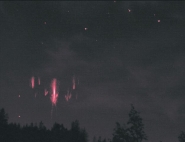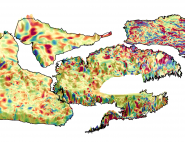Instruments
Completely revolutionary magnetometer design
Each of the satellites in the Swarm mission measures the magnetic field with a combination of three instruments: a Vector Field Magnetometer (VFM), to measure the components of the magnetic field along three axes perpendicular to each other; a star-tracker camera (STR), to calculate the attitude of the field in space; and an Absolute Scalar Magnetometer (ASM), to make high accuracy measurements of the strength of the magnetic field. The absolute scalar precision of the ASM is greater than 65 pT, which is one millionth of the magnitude to be measured. These ASM instruments provide data on the strength of the reference field for the mission, and will be used to calibrate the vector field data provided by the coupling of the VFM instruments with the STR star-tracker cameras. This new-generation scalar magnetometer, designed by the CEA-Leti in Grenoble and supplied by CNES, which also helped to develop the instrument payload for its space mission, offers improved performance without the limitations of proton-procession nuclear magnetic resonance probes used by the Ørsted and CHAMP missions (Overhauser proton-precession scalar magnetometer probes, also developed by CEA-Leti, in collaboration with CNES).
Working principles
The working principle of the absolute scalar magnetometer is based on atomic spectroscopy with Helium 4. It exploits the Zeeman effect, with the signal being amplified by optically-pumped atoms of Helium-4. This innovative technology offers unequalled sensitivity and performance, which remains identical at all points on the orbit. This measurement principle means that the measurements are absolute and have no drift or bias, enabling the magnetometer to be used as a magnetic reference for the Swarm mission. The main challenge with this concentration of technologies lay in qualifying its components for use in space, especially a fibre laser source and a non-magnetic piezoelectric motor. Swarm will provide the first opportunity for these technologies to be carried into space. Choosing and qualifying non-magnetic materials was also a challenge, with pure PEEK (a polymer with no fillers) being selected for its non-magnetic properties. This is the first time that the material has been used to build a complex mechanical structure for a space application, with sensors consisting of many components including mobile parts, and screws to reinforce mechanical resistance.
The ASM nominally provides a set of measurements every second. However, it is also capable of providing scalar measurements at a frequency of 250 Hz. This capability will be used at the beginning of the life-cycle to analyze the spectral content of the magnetic field above 1 Hz, about which little is currently known.
Absolute vector field measurement
The innovative design of the instrument also enables it to take absolute vector field measurements, or in other words to take absolute measurements of the components of the magnetic fields along three axes perpendicular to each other. As a result, it is the first instrument, with excellent stability, capable of taking both scalar and vector measurements simultaneously at the same point. Swarm thus provides a unique opportunity to validate this concept in the space environment. It will therefore be possible to compare the experimental vector field data provided by the ASM with the nominal measurements of the VFM for validation purposes. The results will also make it possible to verify the quality of the mission's nominal data, and may open up particularly interesting possibilities for future missions based on space magnetometry. It could free such missions from the need to carry both an absolute scalar magnetometer and a relative vector field magnetometer
Absolute Scalar Magnetometer: sensors and Digital Processing Unit (DPU) © CEA-Leti / G. Cottet |
Swarm absolute magnetometer: an innovative instrument at the cutting edge of technology
- Unique functions and unequalled performances (in French)
- Swarm laser: a world premiere (in French)
- A complex mechanical structure entirely made of PEEK (in French)
More detailed information on this instrument is available in the following links:
An "automatic ground observatory" based on the ASM
One of the engineering models of the ASM was adapted to create a prototype for an automatic magnetometer for ground-based observation. The vector field mode was improved to enable performance comparable to that of the fluxgate magnetometers currently used in these stations. One advantage of this prototype is that its stability should mean that it will not require calibrating more than once a year, whereas the equipment currently used in laboratories has to be calibrated several times a week. The prototype is currently being tested at IPGP's magnetic observatory in Chambon-La-Forêt. Once validated, the instrument could be installed in ground-based observatories in remote regions that are difficult to access, thus complementing the measurements provided by the Swarm constellation. This experiment is carried out jointly by CNES, CEA-Leti and IPGP.


